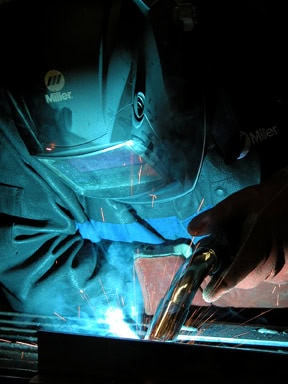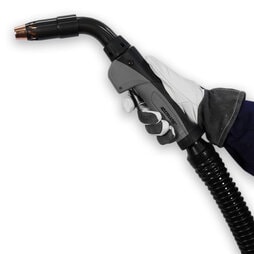Attacking Weld Fume at the Source

maintain compliance with safety regulations
and create a cleaner, more comfortable welding
environment. Proper use and maintenance of the
equipment is important to get optimal results.
The Occupational Safety and Health Administration (OSHA) and other safety regulatory bodies set the allowable exposure limits for weld fumes and other particulates, including hexavalent chromium, with the aim of protecting employees against potential health hazards in the workplace. Providing welding operators with proper ventilation during the welding process is an important step companies can take to help meet the standards — and to help provide a safe and comfortable work environment.
Companies may opt to invest in centralized fume extraction systems, which are designed to protect the entire shop area. These systems involve the installation of new ductwork and fans to remove fumes and are highly effective, but they are also more expensive than other options. A viable alternative for some companies is a fume extraction gun used in conjunction with a fume extraction device or localized filtration system.
Fume extraction guns are available in a variety of amperages (typically 300 to 600), cable styles and handle designs. As with any welding equipment, they have their best applications, advantages and limitations, as well as recommended techniques for achieving the best results.
The basics
Fume extraction guns operate by capturing the fume generated by the welding process right at the source, over and around the weld pool. The weld fumes removed by these guns are composed of a combination of the filler metal and base material.
Various manufacturers have proprietary means of constructing guns to conduct this action, but at a basic level they all operate similarly: by mass flow, or the movement of material. A vacuum chamber suctions the fumes through the handle of the gun, into the gun’s hose and through to a port on the filtration system (sometimes informally referred to as a vacuum box).
Typically, fume extraction guns are larger than regular welding guns, and include the vacuum and hose that are necessary to extract the fumes. Some manufacturers offer fume extraction guns with a vacuum hose swivel on the rear of the handle to make them easier to maneuver. Also, design advancements have minimized the handle weight and size to make the guns as light as possible for operator comfort, while still offering consistent fume extraction benefits.
Benefits of fume extraction guns
Fume extraction guns are especially well-suited for applications using solid welding wire and for those in confined spaces, where the goal is to capture fumes immediately at the source, in the welding operator’s breathing zone. Industries where these applications often occur include shipbuilding and heavy equipment manufacturing, as well as general manufacturing and fabrication applications utilizing mild or carbon steel. Petrochemical or other applications where stainless steel welding and greater hexavalent chromium levels are prominent may also present the opportunity to use a fume extraction gun. The guns work well on high amperage and high deposition rate applications.
For the best results, fume extraction guns should be used for in-position welding, such as on flat butt welds. In this position, they can most effectively capture fume particles as they rise from the weld pool. It’s more difficult for a fume extraction gun to draw fume particles downward and through the vacuum hose in out-of-position welds, because the fume particles rise at a high rate in those cases.
Techniques to maximize performance?The operation of fume extraction guns is similar to that of standard MIG guns, with many of the same recommended best practices. However, there are some techniques that welding operators can follow to help get the best performance from a fume extraction gun. Here are some things to remember:
Watch the degree of angle
Perhaps the most important tip for maximizing performance is using the appropriate degree of angle. With solid wire — the most common filler metal used with fume extraction guns — use a push technique and an angle of 0 to 15 degrees, which is optimal for fume capture. For flux-cored wire (which generates more fume), use a drag technique with a 0 to 15-degree angle. If the parts are set up at a 0 to 30-degree angle and the gun is kept straight (vertical) during the welding process, the fume rises, allowing the fume extraction of the gun to be maximized. Travel speed during either of these welding processes will typically be dictated by the base metal and the wire size used.

the welding process right at the source, over and around the weld
pool. As with any piece of welding equipment, fume extraction
guns benefit from preventive maintenance.
Flux-cored wire allows vacuum adjustment
Because flux-cored wire produces a slag, it generates more weld fume. However, one benefit of using self-shielded flux-cored wire, for example, is it allows the ability to increase the vacuum level of the gun. Welding operators can close off all the vents and extend the shroud as far as possible. This action maximizes the vacuum at the front end of the gun without concern for disturbing the shielding gas, since there is none generates with self-shielded flux-cored wire. When using gas-shielded flux-cored wire, a 0 to 15-degree angle will help maximize fume collection.
Pause at the end
At the end of the weld, welding operators can pause for 10 to 15 seconds, holding the fume extraction gun in place without depositing weld metal. This action allows the gun to capture residual fumes as the weld bead is cooling.
Wire type determines stickout
The contact tip to work distance can be longer — about 1/2 inch to 3/4 inch — when welding with flux-cored wire and a fume extraction gun. With solid wire, welding operators should try to keep the stickout to 1/2 inch or less to maximize fume capture. These lengths are comparable to the stickout lengths used with standard MIG guns.
Experiment with the air control regulator
Some fume extraction guns feature adjustable extraction control regulators at the front of the gun handle, while other guns include this function internally. These regulators allow welding operators to increase suction as needed without affecting shielding gas coverage. The ability to balance between the downward flow of shielding gas and the upward flow of the suctioned air is important. Fume extraction guns need to provide the appropriate amount of shielding gas to protect the weld from defects such as porosity without sacrificing the ability to suction fumes efficiently enough to protect the welding operator. Adjusting the air control regulator to the appropriate level can be a matter of trial and error, so welding operators may want to test it on scrap material to optimize the suction rate before welding on a product.
Proper maintenance and consumable usage
As with any piece of welding equipment, fume extraction guns benefit from preventive maintenance. Caring for them is similar to caring for a standard MIG gun. Also note that using flux-cored wire with these guns requires more frequent gun maintenance than solid wire because of the slag and fumes it generates. Regular maintenance is important to help prevent a clog or spatter buildup, which can limit the fume capture rate.
Inspecting and maintaining the front end of the gun is key to optimizing fume extraction. Frequently inspect the nozzle and contact tip for signs of spatter buildup, which along with blocking the fume extraction can also obstruct shielding gas flow and cause weld defects. Spatter buildup also can cause consumables to fail prematurely. Replace the consumables if spatter buildup appears, or clean them according to the manufacturer’s recommendations.
Also, inspect the vacuum hose regularly for damage such as cuts or kinks, which can lead to loss of suction. Replace a damaged vacuum hose as necessary.
Regarding consumables, using the manufacturer’s recommended consumables package with a fume extraction gun helps optimize performance, as the guns are engineered to get the best results with specific consumables.
When in doubt about maintenance or any other aspect of using a fume extraction gun, consider working with a trusted welding distributor, certified industrial hygienist and/or the gun manufacturer to address any questions or concerns.
Fume extraction guns can provide results
In combination with many other variables in the welding operation — wire selection, specific transfer methods and welding processes, welding operator technique, and base material selection — fume extraction guns can help companies maintain compliance with safety regulations and create a cleaner, more comfortable welding environment. Proper use and maintenance of the equipment is important to get optimal results.